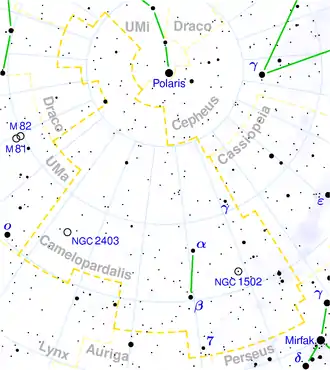Gamma Camelopardalis
γ Camelopardalis (Gamma Camelopardalis, kurz γ Cam) ist ein für das bloße Auge sehr lichtschwacher, höchstwahrscheinlich physischer (gravitativ gebundener) Doppelstern[8] im zirkumpolaren Sternbild Giraffe (lateinisch Camelopardalis). Die Hauptkomponente A leuchtet mit einer scheinbaren Helligkeit von 4,63m am Nachthimmel.[2] Die Entfernung des Doppelsternsystems von der Erde beträgt nach neuen, im Dezember 2020 veröffentlichten Auswertungen der Messergebnisse der Raumsonde Gaia etwa 386 Lichtjahre.[1]
| Stern Gamma Camelopardalis | |||||||||||||||||
|---|---|---|---|---|---|---|---|---|---|---|---|---|---|---|---|---|---|
| |||||||||||||||||
| AladinLite | |||||||||||||||||
| Beobachtungsdaten Äquinoktium: J2000.0, Epoche: J2000.0 | |||||||||||||||||
| Sternbild | Giraffe | ||||||||||||||||
| Rektaszension | 03h 50m 21,51s [1] | ||||||||||||||||
| Deklination | +71° 19′ 56,2″ [1] | ||||||||||||||||
| Helligkeiten | |||||||||||||||||
| Scheinbare Helligkeit | 4,63 mag [2] | ||||||||||||||||
| Spektrum und Indices | |||||||||||||||||
| B−V-Farbindex | +0,03 [3] | ||||||||||||||||
| U−B-Farbindex | +0,07 [3] | ||||||||||||||||
| Spektralklasse | A2 IVn [4] | ||||||||||||||||
| Astrometrie | |||||||||||||||||
| Radialgeschwindigkeit | (0.2 ± 2.5) km/s [5] | ||||||||||||||||
| Parallaxe | (8.4446 ± 0.0826) mas [1] | ||||||||||||||||
| Entfernung | (386 ± 4) Lj (118 ± 1) pc [1] | ||||||||||||||||
| Visuelle Absolute Helligkeit Mvis | −0.73 mag [Anm 1] | ||||||||||||||||
| Eigenbewegung [1] | |||||||||||||||||
| Rek.-Anteil: | (+18.435 ± 0.069) mas/a | ||||||||||||||||
| Dekl.-Anteil: | (−41.956 ± 0.073) mas/a | ||||||||||||||||
| Physikalische Eigenschaften | |||||||||||||||||
| Masse | (2.98 ± 0.04) M☉ [6] | ||||||||||||||||
| Radius | 2.5 R☉ [7] | ||||||||||||||||
| Leuchtkraft | |||||||||||||||||
| Effektive Temperatur | 8890 K [6] | ||||||||||||||||
| Andere Bezeichnungen und Katalogeinträge | |||||||||||||||||
| |||||||||||||||||
| Anmerkung | |||||||||||||||||
| |||||||||||||||||
Der hellere Hauptstern A ist ein weiß leuchtender Unterriese der Spektralklasse A2.[4] Er rotiert sehr schnell mit einer projizierten Rotationsgeschwindigkeit von etwa 191 km/s,[6] wodurch er nicht rund, sondern abgeplattet erscheint. Seine Masse beträgt etwa zwei Sonnenmassen und er strahlt mit ungefähr 185 Sonnenleuchtkräften bei einer effektiven Temperatur von rund 8900 K.[6]
Der gravitativ gebundene Begleiter des Hauptsterns von γ Camelopardalis, BD +70 260,[9] wird als Komponente C bezeichnet und besitzt eine scheinbare Helligkeit von 9,07m. Er befand sich im Jahr 2015 in einer Winkelentfernung von 106,0 Bogensekunden entlang eines Positionswinkels von 85° von der Hauptkomponente.[2] Die 12,40m helle Komponente B ist ein weiterer Begleiter und stand 2011 in einer Distanz von 56,30 Bogensekunden entlang eines Positionswinkels von 247° vom Hauptstern.[10]
Weblinks
Anmerkungen
- Gaia early data release 3 (Gaia EDR3) für γ Cam A, Dezember 2020
- γ Camelopardalis AC im Washington Double Star Catalog.
- H. L. Johnson, B. Iriarte, R. I. Mitchell, W. Z. Wisniewskj: UBVRIJKL photometry of the bright stars. In: Communications of the Lunar and Planetary Laboratory. 4, 1966, S. 99–110. 1. bibcode:1966CoLPL...4...99J. (Datensatz auf VizieR)
- A. Cowley, C. Cowley, M. Jaschek, C. Jaschek: A study of the bright A stars. I. A catalogue of spectral classifications. In: Astronomical Journal. 74, April 1969, S. 375–406. bibcode:1969AJ.....74..375C. doi:10.1086/110819.
- J. H. J. de Bruijne, A.-C. Eilers: Radial velocities for the HIPPARCOS-Gaia Hundred-Thousand-Proper-Motion project. In: Astronomy & Astrophysics. 546, Oktober 2012, S. 14. arxiv:1208.3048. A61. bibcode:2012A&A...546A..61D. doi:10.1051/0004-6361/201219219. (Datensatz auf VizieR)
- J. Zorec, F. Royer: Rotational velocities of A-type stars. IV. Evolution of rotational velocities. In: Astronomy & Astrophysics. 537, Januar 2012. arxiv:1201.2052. A120. bibcode:2012A&A...537A.120Z. doi:10.1051/0004-6361/201117691. (Datensatz auf VizieR)
- L. E. Pasinetti Fracassini, L. Pastori, S. Covino, A. Pozzi: Catalogue of Apparent Diameters and Absolute Radii of Stars (CADARS). In: Astronomy and Astrophysics. 367, Nr. 2, 2001, S. 521–524. arxiv:astro-ph/0012289. bibcode:2001A&A...367..521P. doi:10.1051/0004-6361:20000451. (Datensatz auf VizieR)
- P. P. Eggleton, A. A. Tokovinin: A catalogue of multiplicity among bright stellar systems. In: Monthly Notices of the Royal Astronomical Society. 389, Nr. 2, September 2008, S. 869–879. arxiv:0806.2878. bibcode:2008MNRAS.389..869E. doi:10.1111/j.1365-2966.2008.13596.x. (Datensatz auf VizieR)
- Gaia early data release 3 (Gaia EDR3) für γ Cam C (= BD +70 260), Dezember 2020
- γ Camelopardalis AB im Washington Double Star Catalog.
